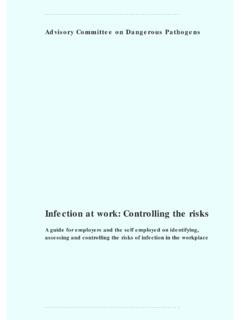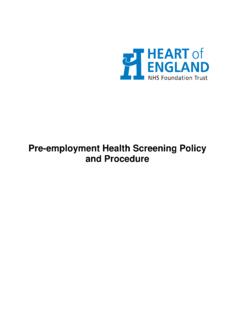Transcription of Blood-borne viruses in the workplace INDG342
1 Health and Safety Executive Blood-borne viruses in the workplace Guidance for employers and employees Is this guidance useful to me? If you are an employer or employee, self-employed or a safety representative, and involved in work where exposure to blood or other body fluids may occur, you should read this guidance. It will help you to understand: what Blood-borne viruses (BBVs) are;. the types of work where exposure to BBVs may occur and how BBVs are spread;. the legal duties of employers and employees;. the action to be taken after possible infection with a BBV;. special considerations for first aiders. Detailed guidance on BBVs is already available for those in certain industries, for This is a web-friendly example health care (see Further reading').
2 This simple leaflet will be of particular version of leaflet INDG342 use to those in occupations where such detailed guidance is not available. What are Blood-borne viruses (BBVs)? BBVs are viruses that some people carry in their blood and which may cause severe disease in certain people and few or no symptoms in others. The virus can spread to another person, whether the carrier of the virus is ill or not. The main BBVs of concern are: hepatitis B virus (HBV), hepatitis C virus and hepatitis D virus, which all cause hepatitis, a disease of the liver;. human immunodeficiency virus (HIV) which causes acquired immune deficiency syndrome (AIDS), affecting the immune system of the body.
3 These viruses can also be found in body fluids other than blood, for example, semen, vaginal secretions and breast milk. Other body fluids or materials such as urine, faeces, saliva, sputum, sweat, tears and vomit carry a minimal risk of BBV. infection, unless they are contaminated with blood. Care should still be taken as the presence of blood is not always obvious. 1 of 7 pages Health and Safety Executive Types of work where there may be contact with blood/body fluids custodial services (prisons/detention centres/homes). education embalming and crematorium work emergency services (ambulance/fire/police/rescue). first aid hairdressing and beauticians' work health care (hospitals, clinics, dental surgeries, pathology departments, community nursing, acupuncture, chiropody, associated cleaning services).
4 Laboratory work (forensic, research etc). local authority services (street cleaning/park maintenance/refuse disposal/public lavatory maintenance). medical/dental equipment repair military mortuary work needle exchange services plumbing sewage processing social services tattooing, ear and body piercing vehicle recovery and repair (This list is not intended to be comprehensive). How can BBVs be spread in the workplace ? It is very unlikely that you will become infected through everyday social contact with another worker who has a BBV. BBVs are mainly transmitted sexually or by direct exposure to infected blood or other body fluids contaminated with infected blood.
5 In the workplace , direct exposure can happen through accidental contamination by a sharp instrument, such as a needle or broken glass. Infected blood may also spread through contamination of open wounds, skin abrasions, skin damaged due to a condition such as eczema, or through splashes to the eyes, nose or mouth. What do I have to do as an employer? Under the Health and Safety at Work etc Act 1974 and the Management of Health and Safety at Work Regulations 1999, you have a legal duty to protect the health of your employees and anyone else, for example the public, who may be affected by your work, or who may be on your premises at any time. You must have a safety policy and you should consult your employees and safety representatives on the risks identified and the measures needed to prevent or control these risks.
6 You must also ensure employees are familiar with the safety policy. Specific legislation on hazards that arise from working with biological agents such as BBVs is contained in the Control of Substances Hazardous to Health Regulations 2002 (as amended) (COSHH). Under COSHH you have a legal duty to assess the risk of infection for employees and others affected by your work. When the risk is known, you need to take suitable precautions to protect their health. You must also give employees adequate information, instruction and training on any risks to their health which they may face at work. Blood-borne viruses in the workplace : Guidance for employers and employees 2 of 7 pages Health and Safety Executive Assessing the risk The Health and Safety Executive (HSE) has produced general guidance on carrying out a risk assessment (Five steps to risk assessment see Further reading').
7 You need to: identify the hazards where BBVs may be present;. decide who might be harmed and how which employees and others may be exposed to BBVs and how this might happen, for example through dealing with accidents or handling contaminated items for cleaning or disposal;. assess how likely it is that BBVs could cause ill health and decide if existing precautions are adequate or whether more should be done. Factors to consider include: - the frequency and scale of contact with blood or other body fluids;. - the number of different persons' blood/body fluids with which contact is made;. - any existing information on injuries reported in the workplace ;. - the quality of control measures used.
8 Record your findings; and review your risk assessment and revise it, if necessary. Experience shows that the risk of BBV infection is low for the majority of occupations, as direct contact with blood and body fluids does not occur regularly. Much depends on the nature of the exposure. Not all exposures result in infection. Preventing or controlling the risk In occupations where there is a risk of exposure to BBVs, the following measures to prevent or control risks apply, but you may need to adapt them to your local circumstances in ensuring a safe system of work: prohibit eating, drinking, smoking and the application of cosmetics in working areas where there is a risk of contamination.
9 Prevent puncture wounds, cuts and abrasions, especially in the presence of blood and body fluids;. when possible avoid use of, or exposure to, sharps such as needles, glass, metal etc, or if unavoidable take care in handling and disposal;. consider the use of devices incorporating safety features, such as safer needle devices and blunt-ended scissors;. cover all breaks in exposed skin by using waterproof dressings and suitable gloves;. protect the eyes and mouth by using a visor/goggles/safety spectacles and a mask, where splashing is possible;. avoid contamination by using water-resistant protective clothing;. wear rubber boots or plastic disposable overshoes when the floor or ground is likely to be contaminated.
10 Use good basic hygiene practices, such as hand washing;. control contamination of surfaces by containment and using appropriate decontamination procedures (see Decontamination procedures');. dispose of contaminated waste safely (see Disposal of waste'). Blood-borne viruses in the workplace : Guidance for employers and employees 3 of 7 pages Health and Safety Executive immunisation immunisation (vaccination) is available against HBV but not other BBVs. The need for a worker to be immunised should be determined by the risk assessment. It should only be seen as a supplement to reinforce other control measures. As an employer, you should make vaccines available free of charge to employees, if they are needed.











